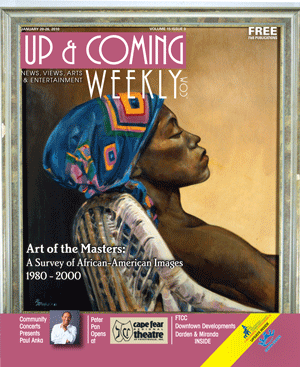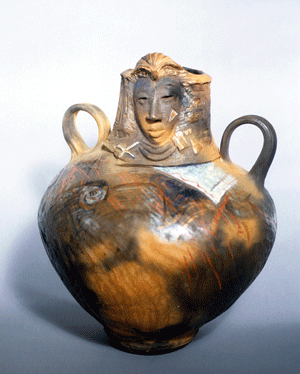 It’s rare that a body of original works of art is exhibited in Fayetteville, N.C.
It is rarer still, that our community has the opportunity to experience, fi rst hand,
the expansive richness and diversity of African-American art in one exhibition.
Art of the Masters: A Survey of African-American Images, 1980-2000 is such an
exhibit and opens Jan. 22 during 4th Friday at the Arts Council of Fayetteville and
Cumberland County at 301 Hay Street.
It’s rare that a body of original works of art is exhibited in Fayetteville, N.C.
It is rarer still, that our community has the opportunity to experience, fi rst hand,
the expansive richness and diversity of African-American art in one exhibition.
Art of the Masters: A Survey of African-American Images, 1980-2000 is such an
exhibit and opens Jan. 22 during 4th Friday at the Arts Council of Fayetteville and
Cumberland County at 301 Hay Street.
After opening at the Schomburg Center for Research in Black Culture in New York City, Fayetteville is the traveling exhibit’s only stop in the Southeast before moving on to Chicago. How the exhibit was scheduled to stop in Fayetteville is equally relevant — especially when the economy remains a signifi cant concern for people and businesses.
The Back Story
For Calvin Mims, arts services director at the Arts Council, and Dwight Smith, instructor of painting at Fayetteville State University, it all began with an outing last year to the North Carolina Art Museum in Raleigh. The men were attending a social event hosted by the Durham Friends of African and African- American Art to unveil the newly purchased sculpture titled Tippy Toes by Allison Saar at the museum. A crowded event, Mims and Smith left with the idea that Fayetteville was ready for such an organization.
With the support of Deborah Mintz, president of the Arts Council, Mims created a steering committee to plan events and begin the fundraising for the Arts Council’s new affi liate — Fayetteville’s Friends of African and African American-Art, known as FAAA.
What began as an effort by Mims, Smith and the steering committee to collect $25 memberships for the FAAA grew into major sponsorships by local businesses and an institution of higher learning to make it possible for Art of the Masters and its suopporting events to become a reality in Fayetteville.
Art of the Masters is touring exhibit through the National Conference of Artists, Michigan Chapters. Specifi c to the exhibition, Mims had this to say, “The purpose of bringing the Art of the Masters exhibition to Fayetteville is to continue our mission at the Arts Council of educating the community of the breadth and depth of contemporary creativity in the African- American community.”
The Exhibit
Visitors to Art of the Masters will experience fi rst hand, the “depth and breadth” of four generations of artists in the African-American community by seeing more than 60 original works of art from 36 national and international artists. Original works by most of the major African-American artists already included in art-history texts are on exhibit. Works by John Biggers, Elizabeth Catlett, Jacob Lawrence, Robert Colescott, Betye Saar, Benny Andrews, David Driskell, Sam Gilliam and many others are there for visitors to the Arts Council to view not just once, but several times.
To view such a renowned group of internationally known artists is to celebrate the importance of these works. Halima Taha, art historian at the Museum of Modern Art, best states this opportunity in the exhibit’s catalogue introduction: “Within the concluding quarter of the 20th century, African-American art — specifi cally functioning within the collective activity of artists, dealers, collectors, curators, auction houses and critics — has become the most actively sought work by private and institutional collectors worldwide. Major collectors of American art are recognizing the historic and aesthetic gaps in their American art collections; and African-American artists are combining a rich and diverse blend of aesthetic traditions from Africa, Asia, Europe, the Caribbean and the Americas. Consequently they are attracting an international audience of collectors to a varied aesthetic with a historic precedent since 1793.”
The varied aesthetic Taha refers to will become immediately obvious. The use of patterns in the works of Frank Smith, Murray Norman DePillars, Willis “Bing” Davis and Shirley Woodson are in contrast to the watery abstraction of Samella Lewis, the stark realism of Hugh Grannum, or the fl oating “Mumbo Jumbo” of Betye Saar.
The Educational Component
Rosenthal Gallery, on the campus of Fayetteville State University, partnered with the Arts Council to host an educational component to the exhibition. Thirty educational panels about most of the artists have been prepared and installed at Rosenthal Gallerty to educate visitors about the artists, including quotes from the artists, biographies, their infl uences and references to the styles of each artist.
Visitors to Rosenthal Gallery can read information about the works before or after they visit the Arts Council to see the original works. While seeing the abstracted fl oating iconographic symbols of Betye Saar, the educational panel includes a quote from the artist’s Web site which gives us insight into her purpose: “I am intrigued with combining the remnant of memories, fragments of relics and ordinary objects, with the components of technology. It’s a way of delving into the past and reaching into the future simultaneously.”
In the case of Sam Gilliam, visitors will learn that he was part of the late abstract expressionist movement that took place with a group of painters in Washington, D. C. Gilliam is attributed as the fi rst artist to paint on stretched canvasses that hung without the support of stretcher bars.
Collectors, art patrons and students of art history will be familiar with the themes of Robert Colescott — satire and social commentary on race, sex and interracial relationships. But it is North Carolina native John Biggers, who is most known in this region by the general public. Biggers was born in 1924 and is one of the pillars of modern African-American art.
An example of the information you will discover about John Biggers in Rosenthal Gallery is the following: “… Biggers became interested in the continent of Africa while attending Lincoln Academy. The principal, previously a missionary in West Africa, urged his students to learn and value African culture. Biggers later attended Hampton Institute, where his Professor Viktor Lowenfeld, a Jewish immigrant from Nazi Germany, re-enforced in him the signifi cance of studying his African heritage. Lowenfeld also introduced him to the art of the Mexican muralists, a style for which he is best known. While at Hampton, artists and intellectuals such as Charles White and Elizabeth Catlett, Hale Woodruff and Dr. Alain Locke infl uenced Biggers’ work.”
His quote on the educational panel in Rosenthal Gallery refl ects the teacher in Dr. John Biggers: “I … see art not primarily as an individual expression of talent, but as a responsibility to refl ect the spirit and style of Negro people. It became an awesome responsibility to me, not a fun thing at all.”
For many that quote rings true, particularly today, about the need for artists, people in a community and agencies in a community to be responsible for, as the artist Romare Bearden once said, “Adding to our existing concept of reality.”
Parallel to the meaning of the words of Bearden, Dr. James Anderson, chancellor of Fayetteville State University, had this to say about the Art of the Masters exhibit and the educational component in Rosenthal Gallery, “Few things are more wondrous than the moment when the image of an artist moves the spirit and opens a new reality to a viewer. The work of each of these renowned artists represents a national treasure that serves as visual evidence of the vast range of the human experience. Savor the complexities of color, form and fi gure with a child’s inquisitive eye and each picture will have a differentmeaning for each viewer.”
The Lecture Series
Another educational component of the Art of the Masters includes a series of lectures scheduled at Rosenthal Gallery and the Arts Council during the exhibit by local university art professors. The Chancellors’ Distinguished Speaker Series at Fayetteville State University is sponsoring a special event, a lecture in Seabrook Auditorium by the historically important artist David Driskell.
Driskell is a renowned painter, collector of art and is one of the leading authorities on the subject of African-American art and the black artist in American society. His paintings can be found in major museums and private collections worldwide. \Driskell has written several books. His essays on African-American art have appeared in major publications throughout the world, and he has written more than 40 catalogues for exhibitions he has curated.
Although Driskell is known for many achievements, since 1977 Professor Driskell has served as cultural adviser to Bill and Camille Cosby as the curator of the Cosby Collection of Fine Arts. In 2000, in a White House Ceremony, Professor Driskell received the National Humanities Medal from President Bill Clinton.
In addition, a lecture and book signing by Driskell for local- and regionalart students at colleges and universities has been scheduled at the Arts Council. The Arts Council is also sponsoring activities for children and has developed a study guide.
The Schedule
Art of the Masters is a different type of exhibit in Fayetteville that runs from Jan. 22 to March 6. It is not something you visit once, people in the community and the surrounding counties have two months to return the Arts Council or Rosenthal Gallery to refl ect on how, according to Chancellor Anderson, “An artist moves the spirit and opens a new reality to a viewer.” In addition, throughout the months of January to early March many free events have been planned around the exhibition.
Being highly aware of all the effort and work that went into the fi rst year of FAAA, resulting in the Art of the Masters and its scheduled events, it’s easy to take the bigger picture for granted. Mintz stated, “The most wonderful part of FAAA and the exhibit is that it is truly a community endeavor. People from the community came together to raise the money for the exhibit, develop the activities and create the educational components — every piece was planned and undertaken by individuals in the community. It is a community production, sponsored by the many individuals who joined the $25 membership and sponsors from organizations and businesses.”
All the activities are free and open to the public. For a complete list of the
events, visit www.TheArtsCouncil.com. Call the Arts Council
at 910-323-1776 for information or to schedule a time to
have a large group tour Art of the Masters at the Arts Council.